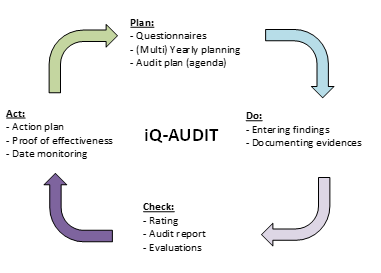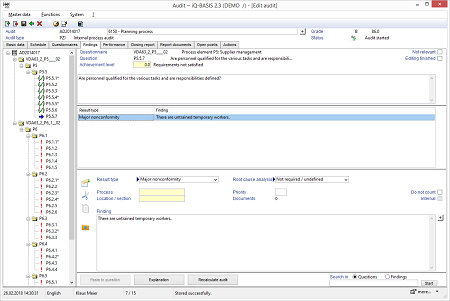The Audit System
Auditing is a cornerstone of any management system for quality, environment or work safety. Conducting audits ensures conformance to relevant standards and provides an important contribution to the continual improvement of systems and processes. The audit process follows the classical PDCA principle (Plan/Do/Check/Act) and is effectively and efficiently supported by the iQ-AUDIT module.
For iQ-AUDIT the type of the managed audits is irrelevant. It supports any audit standard as long as there is a questionnaire representing it and being maintained in the software. The same can be said about the audited unit. It does not matter where the audit takes place - if in the own company (as an internal or 1st party audit or as a certification or 3rd party audit that is conducted by a certifier that should be managed in the software for the purpose of action management and statistics) or if at a supplier. In any case iQ-AUDIT is a flexible assistant.
Workflow
 iQ-AUDIT follows the PDCA principle. The figure shown on the right side shows the most important supported process steps distributed to the 4 phases of this cycle.
iQ-AUDIT follows the PDCA principle. The figure shown on the right side shows the most important supported process steps distributed to the 4 phases of this cycle.
All audits are based on questionnaires. These represent the standards or requirements of which the conformance or fulfilment is audited. iQ-AUDIT is not limited to a specific set of questionnaires but can be flexibly tailored to any imaginable needs.
Prior to auditing is planning. Audits are planned as part of an annual or multi-year planning (audit program) but could also be created spontaneously.
The rather rough planning of the audit program results in audits of which the fine planning is done as audit agendas that are developed in cooperation with the audited unit.
Performing an audit consists of the actual auditing activities (such as interviewing or inspections) and with respect to the software mainly of the input of findings observed during the audit. Entering findings is often easier when there is no need of an immediate assignment to a specific element of the questionnaire so that iQ-AUDIT supports assigning findings in a later step. Furthermore multiple auditors of an audit team are enabled to enter their findings simultaneously and later to import their findings and consolidate them as a team to get actual results.
The final step at the end of or following an audit is to create and publish an audit report. iQ-AUDIT provides a series of tools from a dynamic creation of report contents to the automatic generation of an audit presentation in Microsoft PowerPoint. Any features of iQ-AUDIT are also available in an autarkic version of the software so that auditors are able to conduct any activities of the auditing process independent of any networks.
Nonconformities and opportunities for improvement found during an audit result in an action process that should correct weaknesses and take part in the continual improvement of systems and processes. The actions are defined, implemented and documented by the audited unit and can be evaluated in iQ-AUDIT at any time. The time line coupled to this process is monitored automatically and system escalations to date violations can be configured in almost any way.
Important Features at a Glance
General
- Support of all important types of audits (1st, 2nd and 3rd party audits with relation to quality, processes, environmental systems, work safety, and so on)
- Concise and sortable lists of the questionnaires, demands, audits, and actions available in the system
- Attachment of documents to audits, findings, questions, and actions
- Laptop (autarkic) version for network independent working in a software that is used exactly the same way as the server software
Master data
- Freely definable result and evaluation schemes for a flexible rating of your various audits
- Flexible definition of any kind of questionnaires with the possibility to enter extensive descriptions. Each question can be weighed individually and be provided with own texts for rating.
- Master data that is relevant for other iQ-BASIS modules, too, is maintained in the iQ-GL module so that it can be used throughout the entire application.
Audit planning
- Annual (or multi-year) planning with focus on reusability and release options
- Print function for annual plannings
- Support of single demands for spontaneous audits
- Audit agenda with versioning and ways for cooperation with the audited unit
- Import function for reusing agendas
- Support of any number of questionnaires in an audit and of any audit type
Audit performance
- Adoption and arbitrary change of any questionnaire within the collection
 Entering findings without an immediate assignment to a questionnaire element
Entering findings without an immediate assignment to a questionnaire element
- Drag & drop of findings within the audit questionnaire
- Classification of findings e.g. in good practices, opportunities for improvement, minor nonconformities etc.
- Per finding optional specification of a method for root cause analysis
- Simultaneous entering of findings in audit teams
- Documenting findings by attaching photos
- Search function for determining the correct question to assign a finding to
- Graphical overview of the current ratings
- Software support in formulating the audit report summary text
- Automatic generation of a cover sheet, a findings overview report and an audit presentation (in Microsoft PowerPoint based on a custom template)
- Initiation of the action plan process
Action plan
- Excel action plan for audited units without system access (e.g. in case of supplier audits)
- Intranet solution for a completely database-based process that covers the entire process from the definition of actions over their release to implementation and finally proof of effectiveness
- Optional distribution of findings to multiple action plan coordinators in one audit
- Any number of actions per finding
- Automatic monitoring of single actions and entire action plans including escalation strategies of almost any complexity
Reports / evaluations (some examples)
- Full parametrization of any evaluations by date ranges, audit type and reason, questionnaire, audited unit etc.
- Export of findings, actions, audits etc. to MS Excel
- Pareto analysis for findings with respect to process and location, questions, actions etc.
- Implementation status of planned audits from the planning to the proof of effectiveness of corresponding action plans
- Overview of open and overdue actions
- Audit results and findings in yearly comparisons
Interfaces to Other iQ-BASIS Modules
- iQ-AUDIT mobil to export your audits to a laptop for live editing during the audit
- iQ-GL for a centralized maintenance of all master data that is relevant in other modules, too
- iQ-PROJEKTE for managing actions inside and outside of the audit system.
- iT-Mail when it is necessary to send mails automatically (for example as a result of an overdue action)
- iQ-PORTAL when using the Intranet based action plan
